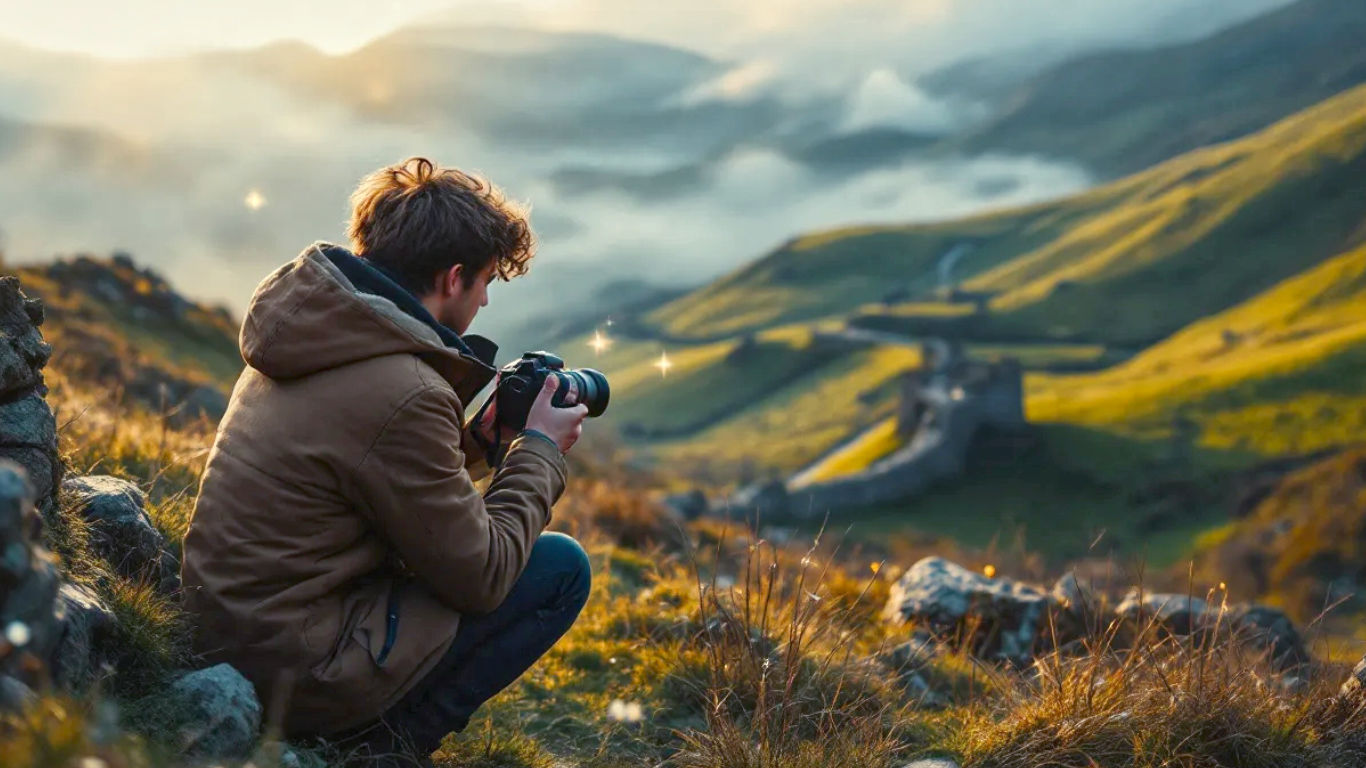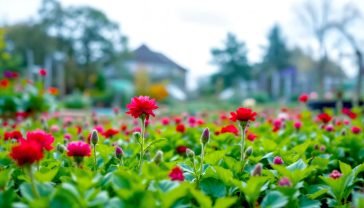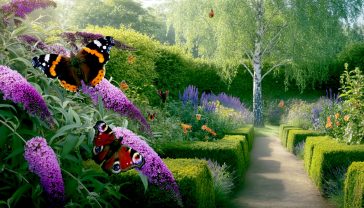The Guide to Photography for Beginners: From Snapshots to Great Shots
A complete beginner’s guide to understanding photography. We break down the essentials like the exposure triangle, composition, and lighting for a British audience.

This post may contain affiliate links. If you make a purchase through these links, we may earn a commission at no additional cost to you.
Photography is more than just pointing a camera and clicking a button. It’s about capturing a moment, telling a story, and seeing the world in a new light. Whether you’re taking snaps of your family on a day out in the Cotswolds, documenting the gritty energy of a London market, or capturing the breathtaking landscapes of the Scottish Highlands, understanding the basics can transform your photos from simple pictures into powerful images.
This guide is for anyone who has ever looked at a stunning photograph and thought, “I wish I could do that.” The good news is, you can. It doesn’t matter if you’ve got a top-of-the-line DSLR or just the smartphone in your pocket. The principles of a good photograph are the same. We’re going to break it all down, step by step, without any confusing jargon. Think of this as a friendly chat over a cuppa, where we’ll demystify the art of photography and give you the confidence to start taking pictures you’re truly proud of.
Part 1: Understanding Your Camera – The Magic Box
Before we get into the creative side of things, we need to understand the tool of the trade: the camera. Modern cameras can seem intimidating with all their buttons and dials, but at their core, they all do the same thing. They capture light.
The Different Types of Cameras
You’ve probably heard terms like DSLR, mirrorless, and compact cameras thrown around. Let’s quickly clear up what they mean.
- Smartphones: Let’s be honest, the best camera is the one you have with you, and for most of us, that’s our phone. Smartphone cameras have become incredibly powerful, with clever software that does a lot of the heavy lifting. They’re perfect for everyday snaps and are a brilliant place to start learning about composition.
- Compact Cameras (Point-and-Shoots): These are small, lightweight cameras with a fixed lens. They offer a bit more control and better image quality than a smartphone, making them a great option for travel or casual photography without the bulk of a bigger camera.
- DSLR Cameras (Digital Single-Lens Reflex): For a long time, these were the go-to for serious amateurs and professionals. They have an internal mirror that reflects the light up into the viewfinder, so you see exactly what the lens sees. They offer fantastic image quality and the flexibility of interchangeable lenses.
- Mirrorless Cameras: These are the new kids on the block and are rapidly becoming the most popular choice. As the name suggests, they don’t have a mirror. Instead, the light goes straight to the sensor, and you see the image on a digital screen or in an electronic viewfinder. They’re generally smaller and lighter than DSLRs but offer the same, if not better, image quality and lens options.
The bottom line? Don’t get too hung up on the gear to start with. The principles we’ll cover apply to all of these. Master the basics on your phone, and if you catch the photography bug, you can always upgrade later.
The Exposure Triangle: The Holy Trinity of Photography
Okay, this is the most technical bit, but it’s the absolute bedrock of photography. Getting your head around the Exposure Triangle is the key to taking control of your camera and moving away from the ‘Auto’ mode.
Exposure is simply how light or dark your photo is. It’s controlled by three things: Aperture, Shutter Speed, and ISO. Imagine you’re filling a bucket with water. The exposure is the full bucket.
- Aperture (How wide the tap is): This is the opening in your lens that lets light in. A wider opening lets in more light, and a narrower one lets in less. Aperture is measured in ‘f-stops’ (e.g., f/1.8, f/4, f/11). This is where it gets a bit counter-intuitive: a small f-number (like f/1.8) means a wide aperture, and a large f-number (like f/11) means a narrow aperture.
- Creative Effect: Aperture also controls the depth of field. This is how much of your photo is in sharp focus. A wide aperture (small f-number) gives you a shallow depth of field, which creates that lovely blurry background (called ‘bokeh’) you see in portraits. A narrow aperture (large f-number) gives you a deep depth of field, where everything from the foreground to the background is sharp, which is ideal for landscapes.
- Shutter Speed (How long the tap is on for): This is the length of time the camera’s sensor is exposed to light. It’s measured in seconds or fractions of a second (e.g., 1/1000s, 1/60s, 2s).
- A fast shutter speed (like 1/1000s) freezes motion. Think of a footballer kicking a ball or a seagull mid-flight.
- A slow shutter speed (like 1s or longer) creates motion blur. This is how photographers get those beautiful, silky waterfall shots or capture light trails from cars at night. A tripod is a must for slow shutter speeds to keep the camera steady.
- ISO (The pressure of the water): This is your camera’s sensitivity to light. Back in the days of film, you’d buy film with a specific ISO. Now, it’s a digital setting. A low ISO (like 100 or 200) is used in bright light and gives you the best quality image. A high ISO (like 3200 or 6400) is used in low light to make the camera more sensitive.
- The Trade-Off: The catch with ISO is that the higher you go, the more digital ‘noise’ or grain you introduce into your photo, which can make it look a bit speckled and reduce the quality. Always try to use the lowest ISO you can for the lighting conditions.
These three elements work together. If you change one, you have to adjust another to keep the exposure balanced. For example, if you make the aperture narrower (a larger f-number) to get more of a landscape in focus, you’re letting in less light. To compensate, you’ll need to use a slower shutter speed or a higher ISO.
Camera Modes: Taking Off the Stabilisers
Your camera’s mode dial is your gateway to taking control. Here’s a quick rundown of the most important ones:
- Auto (The Green Square): The camera makes all the decisions. It’s fine for quick snaps, but you’re here to learn, so let’s move on!
- Program (P): The camera sets the aperture and shutter speed, but you can control other settings like ISO and white balance. It’s a good step up from Auto.
- Aperture Priority (A or Av): You choose the aperture (to control depth of field), and the camera chooses the right shutter speed for a good exposure. This is a favourite mode for many photographers as it gives great creative control. Perfect for portraits.
- Shutter Priority (S or Tv): You choose the shutter speed (to control motion), and the camera chooses the right aperture. This is brilliant for sports or wildlife photography where you need to freeze action, or for creating motion blur with waterfalls.
- Manual (M): You are in complete control. You set the aperture, shutter speed, and ISO yourself. This might sound scary, but once you understand the exposure triangle, it’s the ultimate way to get exactly the photo you want.
A beginner’s tip: Start with Aperture Priority. It’s the best way to get to grips with depth of field, which is one of the most powerful creative tools in photography.
Part 2: Composition – The Art of Seeing
A technically perfect photo with a bad composition will always be a bad photo. Composition is simply the way you arrange the elements within your frame. It’s how you guide the viewer’s eye and tell your story. The good news is, there are some simple rules that can instantly improve your photos.
The Rule of Thirds
This is the most famous rule in photography, and for good reason. Imagine your frame is divided into nine equal rectangles by two horizontal and two vertical lines. The Rule of Thirds suggests that you should place the most important elements of your scene along these lines, or at the points where they intersect.
Why does this work? Placing your subject off-centre creates a more dynamic and interesting image than placing it right in the middle. When shooting a landscape, try placing the horizon on the bottom third line to emphasise a dramatic sky, or on the top third line to focus on an interesting foreground.
Leading Lines
Our eyes are naturally drawn to lines. Use them to your advantage! Look for roads, paths, fences, rivers, or even the lines on a building. Position yourself so that these lines lead the viewer’s eye from the foreground of the image towards your main subject. It’s a simple but incredibly effective way to create a sense of depth and guide the narrative of your photo.
Framing
This doesn’t mean putting your photo in a picture frame. It means using elements within the scene to create a natural frame around your subject. This could be a doorway, a window, an archway, or overhanging tree branches. Framing adds context, creates depth, and helps to draw attention to your subject by isolating it from the rest of the scene.
Symmetry and Patterns
While the Rule of Thirds is about breaking symmetry, sometimes embracing it can create a really powerful, striking image. Look for reflections in water, architectural details, or natural patterns. Placing your subject dead centre in a symmetrical scene can create a sense of balance and harmony. Patterns are all around us, from the bricks on a wall to the petals on a flower. Filling your frame with a repeating pattern can make for a compelling abstract photo.
Don’t Forget to Change Your Perspective
So many photos are taken from standing height. One of the easiest ways to make your pictures more interesting is to simply change your viewpoint.
- Get Low: Crouch down or even lie on the ground. This can make your subject seem more heroic and allows you to capture interesting foreground details you’d otherwise miss. It’s a great trick for photographing children or pets, as it brings you down to their level.
- Get High: Look for a bridge, a hill, or even just stand on a bench. A higher vantage point can give a sense of scale and reveal patterns in the landscape that you wouldn’t see from the ground.
Part 3: The Magic of Light
Photography is literally ‘drawing with light’ (from the Greek words phos and graphe). Light is the most important ingredient in any photograph. The quality, direction, and colour of the light will completely change the mood and impact of your image.
The Golden Hour: The Best Time of Day
Photographers are obsessed with the ‘Golden Hour’. This is the period shortly after sunrise and before sunset when the light is soft, warm, and golden. The low angle of the sun creates long, beautiful shadows that add depth and texture to your photos. It’s flattering for portraits and makes landscapes glow. If you can, plan your photo walks for these times of day. You’ll be amazed at the difference it makes.
Midday Sun: The Harsh Reality
Shooting in the middle of a sunny day is actually one of the trickiest times. The sun is directly overhead, which creates harsh, dark shadows (especially under people’s eyes) and bright, blown-out highlights. If you have to shoot at midday, look for areas of open shade, like under a large tree or in the shadow of a building. This will give you much softer, more even light.
Overcast Days: Nature’s Softbox
Don’t be put off by a classic grey British day! An overcast sky acts like a giant softbox, diffusing the sunlight and creating a beautiful, soft, even light with minimal shadows. This is perfect for portraits, as it’s very flattering on skin. It’s also great for capturing vibrant colours in nature, as there’s no harsh sun to wash them out.
Using the Direction of Light
Think about where the light is coming from in relation to your subject.
- Front Light (Light behind you): This illuminates your subject evenly. It’s safe, but can sometimes look a bit flat.
- Side Light: This is when the light comes from the side. It’s fantastic for creating texture and drama, as it casts long shadows that reveal the shape and form of your subject. It’s brilliant for landscapes and characterful portraits.
- Backlight (Light behind the subject): This can be tricky, but very rewarding. It creates a beautiful rim of light around your subject, separating them from the background. It can also create dramatic silhouettes if you expose for the bright background rather than the subject.
Part 4: Putting It All Together – A Practical Guide
Okay, we’ve covered the theory. Now, how do you actually apply it?
Essential Gear (That Won’t Break the Bank)
You don’t need a bag full of expensive kit to start. Here are a few things that will make a big difference:
- A Spare Battery: There’s nothing worse than your camera dying just as the light gets perfect.
- A Memory Card: Get one with a decent amount of space. You’ll take more photos than you think.
- A Microfibre Cloth: For cleaning your lens. A smudgy fingerprint can ruin a great shot.
- A Tripod: If you’re serious about landscape photography or want to experiment with long exposures, a sturdy tripod is essential. It doesn’t have to be a top-end one to begin with.
Choosing a Lens
If you have a camera with interchangeable lenses, the lens you choose has a huge impact. Lenses are measured by their focal length in millimetres (mm).
- Wide-Angle Lenses (e.g., 16-35mm): These capture a wide field of view, making them perfect for landscapes, architecture, and interior shots.
- Standard Lenses (e.g., 50mm): Often called a ‘nifty fifty’, a 50mm lens gives a field of view that’s roughly similar to the human eye. It’s a fantastic, versatile lens for street photography, portraits, and general-purpose shooting.
- Telephoto Lenses (e.g., 70-200mm): These bring distant subjects closer, making them the go-to for sports and wildlife photography. They also create a lovely compressed background, which is great for flattering portraits.
A good starting point is a kit lens (often an 18-55mm zoom) that comes with the camera, as it covers a good range. The next step for many is a 50mm f/1.8 prime lens. ‘Prime’ means it doesn’t zoom, but they are typically sharper and have a much wider aperture than zoom lenses, allowing you to get that beautiful blurry background.
The Art of Editing
Taking the photo is only half the battle. Editing is where you can really make your images shine. It’s the modern-day equivalent of the darkroom. You don’t need to do much. Simple adjustments to brightness, contrast, and colour can make a huge difference.
- Software: There are lots of options available. For beginners, the free apps on your smartphone (like Snapseed) or the software that came with your computer are a great place to start. If you want to get more serious, Adobe Lightroom is the industry standard. It’s a fantastic tool for organising and editing your photos.
- Shoot in RAW: If your camera allows it, switch from shooting JPEGs to shooting in RAW. A JPEG is a compressed file where the camera has already made some editing decisions for you. A RAW file is like a digital negative – it contains all the unprocessed data from the camera’s sensor. This gives you much more flexibility when you’re editing. You can recover details from shadows and highlights that would be lost in a JPEG.
- The Basic Adjustments: Don’t be overwhelmed by all the sliders. The most important ones to start with are:
- Exposure: Make the overall image brighter or darker.
- Contrast: Increase or decrease the difference between the light and dark areas.
- Highlights & Shadows: Fine-tune the brightest and darkest parts of the image.
- White Balance: Correct the colour temperature to make the whites look truly white.
- Vibrance & Saturation: Boost the colours (use Vibrance for a more subtle effect).
- Cropping & Straightening: Straighten a wonky horizon and crop the image to improve the composition.
The key to good editing is to be subtle. The goal is to enhance the photo, not to make it look unnatural.
Go Out and Practise!
You can read all the guides in the world, but the only way to get better at photography is to take photos. Lots of them. Don’t be afraid to experiment and make mistakes. Set yourself little projects. Try to take a photo of something red every day for a week. Go on a photo walk around your local town and try to find interesting patterns and textures. The more you shoot, the more you’ll start to see the world like a photographer. You’ll notice the way the light falls on a building, the leading lines of a country lane, and the fleeting expressions on people’s faces.
Photography is a journey, not a destination. It’s a wonderful hobby that gets you out and about, encourages you to look at the world more closely, and allows you to create something beautiful. So, grab your camera, charge your battery, and go and capture your corner of the world.
Further Reading & Resources
For those looking to continue their photography journey, here are some highly respected UK-based resources:
- Amateur Photographer: One of the oldest and most respected photography magazines in the world, offering news, reviews, and techniques. https://www.amateurphotographer.co.uk
- ePHOTOzine: A comprehensive UK photography website with reviews, news, a friendly community forum, and competitions. https://www.ephotozine.com
- The Royal Photographic Society: An educational charity promoting the art and science of photography. They offer workshops, exhibitions, and qualifications. https://rps.org
- Wex Photo Video: One of the UK’s largest photography retailers, their blog and YouTube channel are packed with tutorials and gear guides for all levels. https://www.wexphotovideo.com/blog






